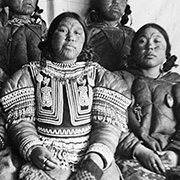
As the people traveled, probably following various herds of animals, across the land bridges of the Alaska-Bering straits route, they slowly began to spread out into the inhabitable areas of Northwestern America. As the earth warmed up, the ice masses melted and receded. This opened vast new areas for these aboriginal people to exploit and migrate into. As they slowly adapted and moved south and east, they developed intuitive, resourceful solutions to the challenges which faced them in each new and different environment. The North was cold and barren but could provide a living to the hardy. The West Coast was rich and bountiful with salmon teeming in the rivers and streams and rich lush rainforests. The prairies supported huge herds of buffalo and endless stretches of grasslands. The Canadian shield contained hundreds of thousands of lakes and enough game and wildlife to support the hunter. South central Canada and the St Lawrence River valley offered forests, food and good land which could produce plentiful crops for those people who solved the mystery of irrigation. The east coast produced endless schools of fish along the Grand Banks and into the streams and lakes of the area. The land became rich and productive and the people who occupied it became diverse, different, and culturally unique.
The indigenous migration to North America refers to the movement of various indigenous peoples from Asia to North America that occurred over thousands of years. It is believed that the first people arrived in North America via a land bridge between Asia and North America during the last Ice Age, when sea levels were much lower and the land bridge was exposed.
Over time, different indigenous groups spread throughout North America, each with their own unique cultures, languages, and traditions. Some of the indigenous peoples who have lived in North America for thousands of years include the Inuit of the Arctic, the Plains tribes of the Great Plains, the Northwest Coast tribes, and the indigenous peoples of the Southwest.
Yes, there were several waves of indigenous migration to North America. The first wave of migration is believed to have occurred between 20,000 and 15,000 years ago, when the first humans arrived in North America via a land bridge between Asia and North America. Over time, different indigenous groups spread throughout North America and developed their own unique cultures, languages, and traditions.
Later waves of migration occurred as indigenous peoples were forced to move from their ancestral lands, either as a result of war, disease, or other factors. For example, the forced removal of indigenous peoples from their lands in the southeastern United States during the 19th century, known as the Trail of Tears, resulted in the migration of thousands of indigenous people to new lands in present-day Oklahoma.
Indigenous peoples in what is now Canada experienced their own unique patterns of migration and movement. These migrations were often shaped by factors such as the search for new hunting and fishing grounds, changes in climate, and the need to escape conflict or persecution.
For example, the Inuit of the Arctic have lived in the region for thousands of years and have a deep connection to the land and the animals that inhabit it. They have a long history of migration and movement within the region, as they followed the migration patterns of the animals they hunted, such as caribou, whales, and seals.
Similarly, the indigenous peoples of the Pacific Northwest, including the Kwakwaka'wakw, Haida, and Tlingit, have a rich history of migration and trade along the coast. These communities were connected by trade routes and social networks that allowed them to exchange goods and ideas and to form alliances with one another.
In general, the indigenous migrations in what is now Canada before European contact were shaped by a complex interplay of environmental, economic, and cultural factors, and these migrations helped to shape the diverse and rich cultures that are an important part of Canada's heritage today.